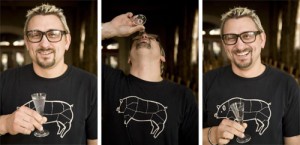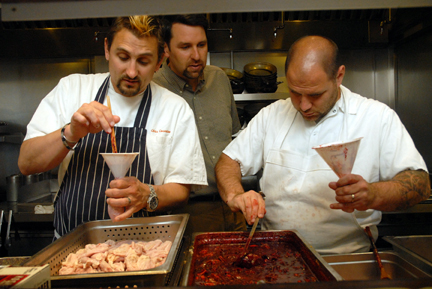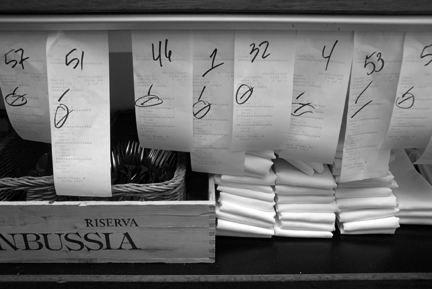Archive for March, 2010
Pot calls the kettle black!!
March 10, 2010 on 2:35 pm | In Blog, Issues | 3 CommentsPETA’s Euthanasia Rates Have Critics Fuming
Do you have the guts 2.0 WINNERS
March 2, 2010 on 9:44 pm | In Blog, Events, Restaurants | 1 Comment
After recieving 50 applicants from all over the US and Canada I have made my final decisions on the 2 stages for this years head to tail dinner at Incanto. This was not an easy decision since there were so many great applicants with great essays and resumes. But there can only be 2 people there is only so much room in our kitchen. Thank you all for your interest in being a part of this annual event just because you didnt get it this time dosent mean you wont get it next year.
Below are the winners names and essays:
Michael Hudman chef/partner of Andrew Michael Italian Kitchen in Memphis Tennessee
Hello Chef, my name is Michael Hudman, chef and co-owner of Andrew Michael Italian Kitchen in Memphis, TN. I could tell you all about me and where I have worked in the past, but the main thing is I am very passionate about food and especially about nose to tail. Two years ago I opened my restaurant with my long time friend and business partner. We concentrate on bringing the best product we can to our customers. We are constantly trying to learn more and more everyday. When I first came across the offal good web site, it blew me away. There are not many restaurants or books that work offal ingredients or techniques. We have done a lot of trial and ERROR with offal, your web site has helped us improve. Last year we closed the restaurant down for a week and made a trip out to San Francisco and Napa. We ate at Incanto twice, the second time we did the Il Quinto Quarto menu and the dinner just stuck with me. (You even waited on a taxi cab for an hour with us, Thanks) It reminded me of the food my grandmother told me about as a kid and the food that we experienced in Italy while in school. At my restaurant we do a Nose to Tail dinner all with Newman Farm pork . We love pork and use it as much as we can, we are working on our charcuterie every day. Speaking of, I saw that y’all are making nduja, we have not had that since we were in Calabria. We are excited about tasting it next time we are in California. You have definitely inspired me to use more offal and push myself as a cook. It would be an honor to learn from you, thank you for your time and I hope to be able to help you and your staff on this year Nose to Tail dinner.
Jonah Resnick a line cook from Blackbird in Chicago
Cooking and working in a kitchen is a non-stop opportunity to learn and improve techniques on a daily basis. To have the chance to work in your kitchen for a week prepping and cooking the Head to Tail dinner would be one of those times where learning new techniques from you and your crew would be an honor. Eating and cooking offal and whole animal butchery is a passion of mine that I look to improve and get inspired by new ideas whenever the opportunity presents itself through other chefs, books, recipes, and blogs. I have worked in well-respected kitchens in both New York and Chicago so working long hours in the kitchen is nothing new for me. You would not have to be concerned with “baby sitting” me during the week. I would love the opportunity to do whatever was needed of me just keeping my eyes open learning the way you execute the Head to Tail dinner from start to finish. I currently work at Blackbird in Chicago where we focus on locally sourced produce and meats and turning them into upscale dishes. I have been there for a year and a half and have worked my way through all of the stations and continue to improve, learn, and help with menu development. Working for Paul Kahan and Chef de Cuisine Mike Sheerin has had a profound impact on me as a cook, as well as a chef, and I will carry the techniques, ideas, and philosophies on food with me for the duration of my career. However, I believe that traveling, eating, and experiencing other parts of the country and world is an invaluable part of becoming a well-rounded chef and cook. I was lucky enough to travel to San Francisco over the summer and experience the local food culture all over the Bay Area. I was blown away by places like the Ferry Building and the farmers market there, the produce, meat, and seafood available in one place blew my mind. While I was visiting the Bay Area I was lucky enough to eat dinner at Incanto and actually speak to you while eating at the bar. I had a wonderful meal there and really loved what you and your cooks were doing with food. Once I read that there was a chance to come there and cook the Head to Tail dinner I immediately jumped at the opportunity. That being said, please consider me for one of the two available positions to stage during the Head to Tail dinner. You will not be disappointed by my dedication and ability in the kitchen.
Skoal!!!!
March 2, 2010 on 12:51 pm | In Blog, Press | No Comments
To have a shot of aquavit at 11am in the morning is not how I like to start my day, but when David Arnold called and asked me to do this shoot I jumped at the chance.His thought is you can learn a lot about a person from their skoal. Read below to learn about Skoal. Or go to Cooking Issues Website to see more Skoal photos and get the full treatment.
Straw man
March 1, 2010 on 11:37 am | In Blog, Press, Recipes | 2 CommentsHere is a great article written by my friend Daniel Patterson about cooking with hay. I could go on and talk about cooking with hay but I could never do it as well as daniel so I am going to leave it alone and let you read his well written piece .

Straw man
A barnyard staple takes a surprising turn in the kitchen.
It’s difficult to think of a product more symbolic of agrarian life than hay. As someone who has spent a fair amount of time tromping around farms, I’ve seen quite a bit of it—in barns, bundled in fields, used in displays—but I’d never thought of hay as a culinary ingre dient. Until now.
Hay is one of the most exciting and unexpected additions to my pantry in recent memory. It’s not a new idea, though: Hay has been used for centuries in French and Italian cooking, where large cuts of meat are buried in it and roasted either in the oven or in the dying embers of a fire.
In this country, hay has traditionally played a supporting role. The hay-box cooker has been used for more than 100 years, particularly during World War II as a way to conserve energy. The technology is simple: Bring a covered pot—preferably heavy metal or ceramic—full of food and liquid to a hard boil, then transfer it to a box packed with hay and cover it. The hay keeps the heat in the pot, so in four to eight hours, the stew will be cooked, sans fossil fuels.
From a practical standpoint, hay makes a great cooking medium, keeping heat in and diffusing temperature changes. But it’s the flavor that makes hay an extraordinary ingredient to work with. The taste is sweet and herbaceous, and the aroma is incredible, evocative of farms, pastures, and spaces vast and green and far removed from the city.
The idea came from a conversation with my sous-chef. We were trying to find a new way to cook carrots, and he recalled working in a restaurant in France where the chef cooked pork with consommé and hay for hours at a low temperature, until the meat was tender and the broth an elixir. It seemed like roasting carrots in hay would yield similarly delicious results, so the next weekend at the farmers’ market, I found myself shoving a gigantic bale of hay into the backseat of my car.
Back at the restaurant, we used the hay to made a stock. We burned some of the ends first, to give the stock deeper flavor, then covered the hay with water and let it simmer for about an hour. We tossed in young carrots with olive oil and salt, then combined them with hay and a little hay stock in a heavy enameled-iron pot and cooked them for about 30 minutes at 300°F, until they emerged tender and aromatic. It’s a simple process that can be done with any root vegetable.
Hay has made occasional appearances on American menus over the years. Chris Cosentino, the chef at Incanto, recalls a dish offered years ago at Red Sage, in Washington, D.C., where leg of goat was covered with a mixture of hay and clay, then baked—another traditional European technique. Cosentino, who was inspired to buy his own hay, first used it to cook a whole leg of pork. His menu currently features rabbit braised in hay that he serves with nettles and carrots. “People love the flavor,” Cosentino says, “and the aroma is amazing. Every time we pull one out of the oven, you can smell it across the dining room. It’s intoxicating.”
There’s not much to know about cooking with hay. The easiest way to use it is to throw a little into a stew as it simmers, then remove it before serving. If you roast with it, you should first soak the hay in water, then lay it down as a thick bed for the meat or vegetables. Burning the ends of the hay will give the dish subtle smokiness and depth. You can cover your main ingredient with the hay or not; adding a bit of liquid to the pot will ensure that it doesn’t burn. And if you’re considering eating the hay itself, I wouldn’t. The flavor is great, but unless you’re a farm animal, the texture leaves much to be desired.
Most farms and farm-supply stores carry hay, but because you’ll use it in direct contact with food, make sure it hasn’t been treated with chemical pesticides. And beware: Before you place your order, stake out some serious storage space. A bale of hay is enormous.
At Coi, we haven’t made much of a dent in our stash, which means that there will be hay on the menu for quite a while. So far, we’ve infused oil with hay and used it to confit suckling pig, reserving some of the oil to drizzle into the sauce. We’ve ground salt and hay together to make a crust for beets. We’ve infused it into onion soup, its presence magically transforming a standard flavor into something fascinating and delicious. Hay might not be the same workhorse in the kitchen that it is on the farm, but in my pantry, hay has found a comfortable second home.
CHRIS COSENTINO’S
Rabbit braised with hay
The chef at Incanto likes to poach baby carrots in the braising liquid to serve alongside the rabbit.
INGREDIENTS
2 2½- to 3-lb. rabbits, each divided into six pieces
Salt and freshly ground black pepper
½ cup flour
3 Tbsp. olive oil
1 onion, peeled and cut in half
1 carrot, peeled and cut in half
1 head fennel, cut in half
1 head garlic, cut in half
½ cup white wine
1 fresh bay leaf
1 handful of hay
2 qt. chicken stock
DIRECTIONS
1. Heat the oven to 250°F. Season rabbit pieces with salt and pepper, then dust lightly with flour.
2. In a Dutch oven, heat the oil over medium heat. Sear the rabbit pieces one or two at a time, taking care not to crowd the pan. When the pieces are golden brown, remove and set aside.
3. Add the vegetables and cook until they just begin to brown.
4. Add the wine, bring to a boil, reduce to a simmer, and let cook until it’s reduced to about 2 tablespoons, occasionally scraping the bottom of the pan to loosen any browned bits.
5. Add the bay leaf and hay. Set the rabbit pieces on top of the hay, add the chicken stock, cover the pan, and braise in the oven until the rabbit is tender, about 1½ hours.
6. Transfer the rabbit pieces to a platter and serve warm.
Makes 6 servings
Daniel Patterson is the chef-owner of Coi and a partner at Cane Rosso.
Do you have the guts to cook guts 2.0
January 20, 2010 on 5:53 pm | In Blog, Events, Offal | 3 CommentsI have decided to do something a little different for this year’s head to tail dinner, inspired by the constant requests for knowledge about how to cook offal. Now’s your chance to learn. I will be accepting 2 volunteers to help with the event this year. You get to come into my kitchen and help cook 2 nights of head to tail dinners. You will work your ass off, have some fun and learn a ton, but there are rules to this game. This offer is open to professional cooks only. You will be an unpaid volunteer. You must commit to working in my kitchen for 5 days, from Friday, March 19th through Wednesday the 24th except for Tuesday, which you’ll have off to recover. You must submit your resume and a short essay on why you should be one of the chosen ones. This is a busy time and I don’t have time to be baby sitting. The Head to Tail dinner is a multi-course menu with a shit load of detailed work..
Here is the pay out; you get both of my t-shirts to take home and you will be able to sit down and enjoy the head to tail menu in the dinning room on the last night.
Email your resume and brief essay to me at [email protected] by sunday February 28th. I will make a final decision and contact the 2 lucky winners on March 3rd to confim your participation. Ultimately, this is a fun opportunity to be a part of a great team for a week and learn how to cook some innards.
Powered by WordPress
Entries and comments feeds.
Valid XHTML and CSS. ^Top^





 Become a Fan
Become a Fan